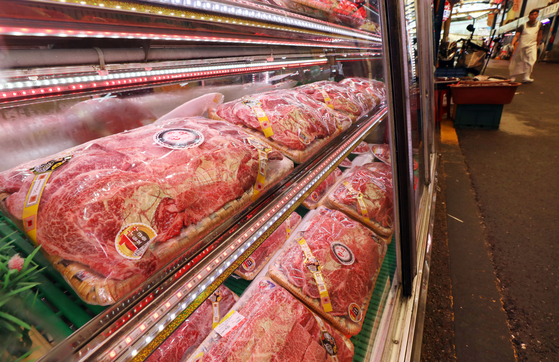
Korean beef on display at the Majang livestock market in Seongdong-gu, Seoul. News 1
In the new year of 2021, the trend of Hanwoot prices, which is one of the national foods, attracts attention in the year of the new year of the year (辛丑年). As the aftermath of the novel coronavirus infection (Corona 19) continues, the life of’Zipcock’ is getting longer.
The beef price is expected to continue the gold price this year. Still, if you want to eat it, the price burden of roasted sirloin and chopped meat is relatively less than that of Yangji and beef bone for soup.
According to the Rural Economic Research Institute on the 3rd, the researcher predicted that the average annual wholesale price of Korean beef was 1,7137 won per kilogram, down 4.6% from the previous year due to oversupply in’Agricultural Outlook 2020′, a year ago in early last year. However, Corona 19 has emerged as a variable. From January to November of last year, the average annual wholesale price of Korean beef recorded 11,917 won per kilogram, up 11.2% from the same period last year. This is because the average purchase of Korean beef per household increased from March to August last year compared to the same period last year.
However, there was a large gap between the parts of the Oreum width. According to the Livestock Quality Assessment Service’s’Price Trends by Korean Beef Parts’, the bulgogi, seoldo, Yangji, and beef dunes, which consume a lot of domestic consumption, rose 13 to 15.8%, respectively, during the same period. On the other hand, in the case of sirloin and chopsticks, which consume a lot of eating out, the average price per kilogram for the month of December rose 9.6% and 6%, respectively, compared to the previous year, showing a relatively small rise. It is analyzed as the aftermath of a decrease in demand for food to go outside due to concerns about the corona19 infection.
In particular, beef bones that are in high demand for eating at home were 2290 won per kg in December 2019, exceeding 4000 won per kg in the same month last year. The price of japbones, which was in the mid-1500 won per kilogram level, also increased by 1,000 won per kilogram, recording 76.6% and 56.5%, respectively. An official from the Rural Development Administration said, “As a result of the ban on meetings of more than five people due to the reinforcement of distance from the metropolitan area, sales of restaurant establishments decreased due to prevention of quarantine, while household consumption increased.” He explained.
Despite concerns over supply oversupply at the beginning of the year, ▶ urgent disaster support payments ▶ expansion of non-face-to-face sales ▶ preference for holiday gift sets. The popularity of Korean beef, which rose a lot last year, is expected to remain popular. As a result of forecasting the price of Korean beef this year by a recent survey of 3,297 Korean beef farmers by the National Korean Beef Association, the highest rate was “Maintaining the price of 20,000 won per kg (42.3%)”. The “downtrend (37.9%)” followed. An official from the Rural Development Administration predicted that “the consumption of meat parts such as soup and bulgogi will increase so that the aftermath of Corona 19 will continue for a considerable period of time this year.”
Domestic beef consumption per capita increased steadily from 1.2 kg in 1970 to 2.6 kg in 1980 → 8.8 kg in 2010 → 13 kg in 2019. The consumption of Korean beef also increased from 3.1 kg in 2010 to 4.1 kg in 2019.
Sejong = Reporter Kihwan Kim [email protected]
